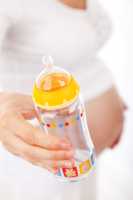
23 Oct Microplastics Released in Baby Bottles During Formula Preparation
MedicalResearch.com Interview with:
Prof. John Boland
AMBER The SFI Research Centre for Advanced Materials and BioEngineering Research,
CRANN, and Trinity’s School of Chemistry
Prof. Liwen Xiao at TrinityHaus and Trinity’s School of Engineering
Trinity College Dublin
 MedicalResearch.com: What is the background for this study?
MedicalResearch.com: What is the background for this study?
Response: There is growing evidence to suggest that micro and nano plastics are released into our food and water sources through the chemical and physical degradation of larger plastic items. Some studies have demonstrated the potential transfer of micro and nano plastics from oceans to humans via the food chain but little is known about the direct release of microplastics (MPs) from plastic products through everyday use – and this is what we wanted to investigate.
Polypropylene (PP) is one of the most commonly produced plastics in the world for food preparation and storage. It is used to make everyday items such as lunch boxes, kettles and infant-feeding bottles (IFBs). Despite its widespread use the capacity of PP to release microplastics was not appreciated until now.
We analysed the potential for release of MPs from polypropylene infant-feeding bottles (PP-IFBs) during formula preparation by following international guidelines. We also estimated the exposure of 12-month-old infants to MPs in 48 countries and regions.
MedicalResearch.com: What are the main findings?
Key findings
- PP-IFBs can release up to 16 million MPs and trillions of smaller nanoplastics per litre. Sterilisation and exposure to high temperature water significantly increase microplastic releasefrom 0.6 million to 55 million particles/l when temperature increases from 25 to 95 °C
- Other polypropylene plastic-ware products (kettles, lunchboxes)release similar levels of MPs
- A global survey estimates exposure of 12-month-old infants to microplastics in 48 regions. Following current guidelines for infant-feedingbottle sterilisation and feeding formula preparation the average daily exposure level for infants is in excess of 1 million MPs. Oceania, North America and Europe have the highest levels of potential exposure, at 2,100,000, 2,280,000, and 2,610,000 particles/day, respectively. The level of microplastics released from PP-IFBs can be significantly reduced by following modified sterilisation and formula preparation procedures
MedicalResearch.com: What should readers take away from your report?
Response: We were surprised by the quantity, and the temperature dependent nature of the results. Based on research that has been done previously looking at the degradation of plastics in the environment we had a suspicion that the quantities would be substantial – but I don’t think anyone expected the very high levels that we found.
It’s important to state we don’t know yet if there are any adverse health effects from exposure to microplastics. However, plastic bottles are light-weight, robust and convenient. Parents of young children can reduce the level of microplastics generated during formula preparation by minimizing the exposure of the plastic bottle to heat and shaking. We’ve come up with a series of recommendations – but the four quickest and easiest steps are to:
- Rinse sterilised feeding bottles with cool sterile water
- Always prepare formula in a non-plastic container,
- After it has cooled to room temperature transfer the formula into the cooled, sterilised feeding bottle.
- Avoid rewarming prepared formula in plastic wares, especially with a microwave oven.
MedicalResearch.com: What recommendations do you have for future research as a result of this work?
Response: “While this research points to the role of plastic products as a direct source of microplastic, the removal of microplastics from the environment and our water supplies remains a key future challenge. Our team will investigate specific mechanisms of micro and nano plastic release during food preparation in a host of different contexts. We want to develop appropriate technologies that will prevent plastics degrading and effective filtration technologies that will remove micro and nanoplastics from our environment for large scale water treatment and local distribution and use.”
“Little is known about the impact of MPs on human health. In the next stage we will investigate the fate, transport and potential impact of MPs following ingestion by infants. As part of this research we will develop a microplastics calculation tool – a mobile APP called microplastics calculator. This tool can be used by parents to roughly estimate the number of MPs their baby takes in everyday
Citation:
Dunzhu Li, Yunhong Shi, Luming Yang, Liwen Xiao, Daniel K. Kehoe, Yurii K. Gun’ko, John J. Boland, Jing Jing Wang. Microplastic release from the degradation of polypropylene feeding bottles during infant formula preparation. Nature Food, 2020; DOI: 10.1038/s43016-020-00171-y
[subscribe]
Last Modified: [last-modified]
The information on MedicalResearch.com is provided for educational purposes only, and is in no way intended to diagnose, cure, or treat any medical or other condition. Always seek the advice of your physician or other qualified health and ask your doctor any questions you may have regarding a medical condition. In addition to all other limitations and disclaimers in this agreement, service provider and its third party providers disclaim any liability or loss in connection with the content provided on this website.
Last Updated on October 23, 2020 by Marie Benz MD FAAD
